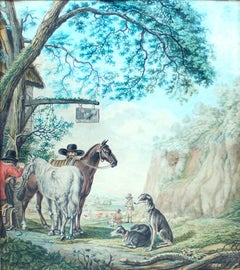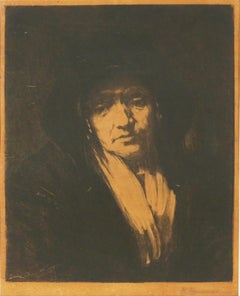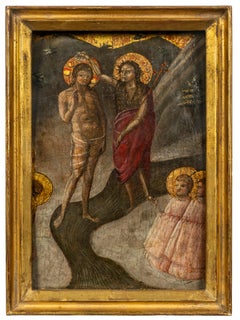Dirk Maas Figurative Paintings
1659-1717
Dirk Maas was a Dutch Golden Age landscape painter. He was born in Haarlem, Netherlands, in 1659.
to
1
1
1
1
Overall Height
to
Overall Width
to
1
1
1
1
1
1
1
1
398
222
205
102
1
1
1
Artist: Dirk Maas
Hunters by Inn-Door - Original Ink and Watercolor by Dirk Maas (attr.)
By Dirk Maas
Located in Roma, IT
Beautiful watercolor by Dirk Maas, a Dutch Golden Age landscape painter.
Provenance: R. Edereimer Print Cabinet, New York (label overleaf).
Good conditio...
Category
Early 18th Century Old Masters Dirk Maas Figurative Paintings
Materials
Ink, Watercolor
Related Items
Original Study of Rembrandt’s Portrait of an Old Woman
Located in Soquel, CA
Early 20th Century Study of Rembrandt’s Portrait of Old Woman Russian for Niello Engraving
A wonderful study of Rembrandt’s portrait of an Old Woman used for Niello engraving by Ru...
Category
Early 20th Century Old Masters Dirk Maas Figurative Paintings
Materials
Ink, Paper
H 28 in W 20 in D 0.33 in
Baptism of Christ
Located in New York, NY
Provenance:
Achillito Chiesa, Milan
Luigi Albrighi, Florence, by 1 July 1955
with Marcello and Carlo Sestieri, Rome, 1969
Private Collection, Connecticut
Exhibited:
Mount Holyoke College Art Museum, South Hadley, Massachusetts (on loan, 2012)
Literature:
Carlo Volpe, “Alcune restituzioni al Maestro dei Santi Quirico e Giulitta,” in Quaderni di Emblema 2: Miscellanea di Bonsanti, Fahy, Francisci, Gardner, Mortari, Sestieri, Volpe, Zeri, Bergamo, 1973, pp. 19-20, fig. 18, as by the Master of Saints Quiricus and Julitta (now identified as Borghese di Piero).
This fine predella panel depicting the Baptism...
Category
15th Century and Earlier Old Masters Dirk Maas Figurative Paintings
Materials
Tempera, Wood Panel
The Abduction of the Sabine Women , a Renaissance drawing by Biagio Pupini
Located in PARIS, FR
This vigorous drawing has long been attributed to Polidoro da Caravaggio: The Abduction of the Sabine Women is one of the scenes that Polidoro depicted between 1525 and 1527 on the façade of the Milesi Palazzo in Rome. However, the proximity to another drawing inspired by this same façade, kept at the Ecole des Beaux-Arts, and to other drawings inspired by Polidoro kept at the Musée du Louvre, leads us to propose an attribution to Biagio Pupini, a Bolognese artist whose life remains barely known, despite the abundant number of drawings attributed to him.
1. Biagio Pupini, a Bolognese artist in the light of the Roman Renaissance
The early life of Biagio Pupini, an important figure of the first half of the Cinquecento in Bologna - Vasari mentions him several times - is still poorly known. Neither his date of birth (probably around 1490-1495) nor his training are known. He is said to have been a pupil of Francesco Francia (1450 - 1517) and his name appears for the first time in 1511 in a contract with the painter Bagnacavallo (c. 1484 - 1542) for the frescoes of a church in Faenza. He then collaborated with Girolamo da Carpi, at San Michele in Bosco and at the villa of Belriguardo.
He must have gone to Rome for the first time with Bagnacavallo between 1511 and 1519. There he discovered the art of Raphael, with whom he might have worked, and that of Polidoro da Caravaggio. This first visit, and those that followed, were the occasion for an intense study of ancient and modern art, as illustrated by his abundant graphic production.
Polidoro da Caravaggio had a particular influence on the technique adopted by Pupini. Executed on coloured paper, his drawings generally combine pen, brown ink and wash with abundant highlights of white gouache, as in the drawing presented here.
2. The Abduction of the Sabine Women
Our drawing is an adaptation of a fresco painted between 1525 and 1527 by Polidoro da Caravaggio on the façade of the Milesi Palace in Rome. These painted façades were very famous from the moment they were painted and inspired many artists during their stay in Rome. These frescoes are now very deteriorated and difficult to see, as the palace is in a rather narrow street.
The episode of the abduction of the Sabine women (which appears in the centre of the photo above) is a historical theme that goes back to the origins of Rome and is recounted both by Titus Livius (Ab Urbe condita I,13), by Ovid (Fasti III, 199-228) and by Plutarch (II, Romulus 14-19). After killing his twin brother Romus, Romulus populates the city of Rome by opening it up to refugees and brigands and finds himself with an excess of men. Because of their reputation, none of the inhabitants of the neighbouring cities want to give them their daughters in marriage. The Romans then decide to invite their Sabine neighbours to a great feast during which they slaughter the Sabines and kidnap their daughters.
The engraving made by Giovanni Battista Gallestruzzi (1618 - 1677) around 1656-1658 gives us a good understanding of the Polidoro fresco, allowing us to see how Biagio Pupini reworked the scene to extract this dynamic group.
With a remarkable economy of means, Biagio Pupini takes over the left-hand side of the fresco and depicts in a very dense space two main groups, each consisting of a Roman and a Sabine, completed by a group of three soldiers in the background (which seems to differ quite significantly from Polidoro's composition).
The balance of the drawing is based on a very strongly structured composition. The drawing is organised around a median vertical axis, which runs along both the elbow of the kidnapped Sabine on the left and the foot of her captor, and the two main diagonals, reinforced by four secondary diagonals. This diamond-shaped structure creates an extremely dynamic space, in which centripetal movements (the legs of the Sabine on the right, the arm of the soldier on the back at the top right) and centrifugal movements (the arm of the kidnapper on the left and the legs of the Sabine he is carrying away, the arm of the Sabine on the right) oppose each other, giving the drawing the appearance of a whirlpool around a central point of support situated slightly to the left of the navel of the kidnapper on the right.
3. Polidoro da Caravaggio, and the decorations of Roman palaces
Polidoro da Caravaggio was a paradoxical artist who entered Raphael's (1483 - 1520) workshop at a very young age, when he oversaw the Lodges in the Vatican. Most of his Roman work, which was the peak of his career, has disappeared, as he specialised in facade painting, and yet these paintings, which are eminently visible in urban spaces, have influenced generations of artists who copied them abundantly during their visits to Rome.
Polidoro Caldara was born in Caravaggio around 1495-1500 (the birthplace of Michelangelo Merisi, known as Caravaggio, who was born there in 1571), some forty kilometres east of Milan. According to Vasari, he arrived as a mason on the Vatican's construction site and joined Raphael's workshop around 1517 (at the age of eighteen according to Vasari). This integration would have allowed Polidoro to work not only on the frescoes of the Lodges, but also on some of the frescoes of the Chambers, as well as on the flat of Cardinal Bibiena in the Vatican.
After Raphael's death in 1520, Polidoro worked first with Perin del Vaga before joining forces with Maturino of Florence (1490 - 1528), whom he had also known in Raphael's workshop. Together they specialised in the painting of palace façades. They were to produce some forty façades decorated with grisaille paintings imitating antique bas-reliefs.
The Sack of Rome in 1527, during which his friend Maturino was killed, led Polidoro to flee first to Naples (where he had already stayed in 1523), then to Messina. It was while he was preparing his return to the peninsula that he was murdered by one of his assistants, Tonno Calabrese, in 1543.
In his Vite, Vasari celebrated Polidoro as the greatest façade decorator of his time, noting that "there is no flat, palace, garden or villa in Rome that does not contain a work by Polidoro". Polidoro's facade decorations, most of which have disappeared as they were displayed in the open air, constitute the most important lost chapter of Roman art of the Cinquecento. The few surviving drawings of the painter can, however, give an idea of the original appearance of his murals and show that he was an artist of remarkable and highly original genius.
4. The façade of the Milesi Palace
Giovanni Antonio Milesi, who commissioned this palace, located not far from the Tiber, north of Piazza Navona, was a native of the Bergamo area, like Polidoro, with whom he maintained close friendly ties. Executed in the last years before the Sack of Rome, around 1526-1527, the decoration of Palazzo Milesi is considered Polidoro's greatest decorative success.
An engraving by Ernesto Maccari made at the end of the nineteenth century allows us to understand the general balance of this façade, which was still well preserved at the time. The frescoes were not entirely monochrome, but alternated elements in chiaroscuro simulating marble bas-reliefs and those in ochre simulating bronze and gold vases...
Category
16th Century Old Masters Dirk Maas Figurative Paintings
Materials
Ink, Gouache, Pen
Follower of Francesco Guardi, Figures in a Mediterranean port by a Roman Arch
By Francesco Guardi
Located in Harkstead, GB
A lively, well executed sketch painted by a 19th century follower of Francesco Guardi
Follower of Francesco Guardi, 19th Century
Figures by a Roman Arch
Watercolour with ink and sc...
Category
19th Century Old Masters Dirk Maas Figurative Paintings
Materials
Paper, Ink, Watercolor
Free Shipping
H 6.5 in W 5 in D 1 in
Italian 18th Century Oval Religious Oil on Canvas Painting with Saint Dominic
By Francesco de Mura
Located in Firenze, IT
This beautiful Italian 18th Century old masters oil painting on oval canvas with giltwood frame is attributed to Solimena and features a religious scene.
In this splendid oval-shaped painting are depicted Saint Dominic...
Category
18th Century Old Masters Dirk Maas Figurative Paintings
Materials
Oil, Canvas
Fine 1700's Italian Old Master Ink & Wash Drawing Roman Allegorical Insubria
Located in Cirencester, Gloucestershire
'Insubria'
Italian School, 18th century
ink and wash drawing on paper, framed within a light oak wood frame (behind glass)
image size: 10.5 x 7 inches
overall framed: 17 x 13 inches
...
Category
18th Century Old Masters Dirk Maas Figurative Paintings
Materials
Ink, Watercolor, Archival Paper
Esther in the Women's House of Ahasuerus
By Artus Wolfort
Located in New York, NY
Born in Antwerp, Artus Wolffordt received his training in Dordrecht where he became a master in 1603 at the age of twenty-two. He returned to his native city in 1615 and initially worked as an assistant to Otto van Veen...
Category
17th Century Old Masters Dirk Maas Figurative Paintings
Materials
Oil, Panel
Baldassarre Franceschini, Sleeping Cupid, Valentine's Day Gift
Located in Harkstead, GB
A beautiful 19th century copy by Giuseppe Rocchi of Baldassarre Franceschini's Sleeping Cupid, presented in a very attractive gilt frame with hand carved mouldings. A very peaceful i...
Category
Mid-19th Century Old Masters Dirk Maas Figurative Paintings
Materials
Paper, Watercolor
17th C Dutch Old Master Ink & Wash Painting Biblical Figures Rembrandt Pupil
Located in Cirencester, Gloucestershire
Figure being Comforted (Job?)
circle of Willem Drost (Dutch 1633-1659) *See notes below
ink and wash drawing on paper (Arms of Amsterdam watermarked)
Dutc...
Category
Mid-17th Century Old Masters Dirk Maas Figurative Paintings
Materials
Ink, Watercolor
18th century English scene of a groom with a horse in a landscape
Located in Woodbury, CT
Wonderful 18th century English gouache on paper of a 18th century English scene of a groom with a horse in a landscape.
One of a set of five all framed in Hogarth frames.
L.Green ...
Category
1780s Old Masters Dirk Maas Figurative Paintings
Materials
Paper, Gouache
Free Shipping
H 11 in W 12 in
Antique Watercolor Painting Muscular Male Nude Classical Roman Pose
Located in Cirencester, Gloucestershire
Muscular Made Nude,
"Olympus"?
sepia watercolour drawing on paper, framed
framed: 23 x 15 inches
painting: 20 x 13 inches
provenance: private collection
condition: very good and sou...
Category
19th Century Old Masters Dirk Maas Figurative Paintings
Materials
Watercolor
Fine 1700's Italian Old Master Ink & Wash Drawing Roman Allegorical Figure Fame
Located in Cirencester, Gloucestershire
'Fame'
Italian School, 18th century
ink and wash drawing on paper, framed within a light oak wood frame (behind glass)
image size: 10.5 x 7 inches
overall framed: 17 x 13 inches
cond...
Category
18th Century Old Masters Dirk Maas Figurative Paintings
Materials
Watercolor, Archival Paper, Ink
Dirk Maas figurative paintings for sale on 1stDibs.
Find a wide variety of authentic Dirk Maas figurative paintings available for sale on 1stDibs. If you’re browsing the collection of figurative paintings to introduce a pop of color in a neutral corner of your living room or bedroom, you can find work that includes elements of blue and other colors. You can also browse by medium to find art by Dirk Maas in ink, paint, watercolor and more. Much of the original work by this artist or collective was created during the 18th century and is mostly associated with the Old Masters style. Not every interior allows for large Dirk Maas figurative paintings, so small editions measuring 10 inches across are available. Customers who are interested in this artist might also find the work of Antonio Savisio, Paul Emile Léon Perboyre, and Goyo Dominguez. Dirk Maas figurative paintings prices can differ depending upon medium, time period and other attributes. On 1stDibs, the price for these items starts at $6,942 and tops out at $6,942, while the average work can sell for $6,942.


